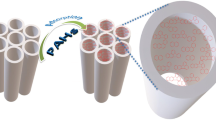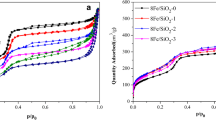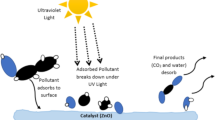Abstract
Nanostructured mesoporous materials of MCM-41 type were synthesized using a natural, non-toxic, and cheap source of silica from rice husk. Then, this pure silica was modified with several Fe loadings by a wet impregnation method. The chemical and physic properties of MCM-41 solids obtained were similar to those of MCM-41 synthesized from commercial silica by conventional method. Thus, all catalysts exhibited good structural regularity preserving the mesoporosity after the metal incorporation. The performance of the Fe/MCM-RHA composites as photo-Fenton heterogeneous catalysts was evaluated for photocatalytic degradation of different endocrine-disrupting chemicals (EDCs), such as herbicides (atrazine), and compounds derived from the plastic industry (bisphenol A) and the pharmaceutical industry (acetaminophen). The major photo-catalytic efficiency obtained (Fe/MCM-RHA(2.5)) is consistent with the highest presence of iron species, which are finely dispersed and stabilized on the silica structure, the isolated Fe3+ ions being the accessible and active sites for the reaction. Finally, a cheaper solid arising from the valorization of residual biomass and with excellent photocatalytic performance for the degradation of EDCs (above 99%, 75%, and 60% for BPA, ATZ, and ACE respectively, in a reaction time of 240 min) was obtained.










Similar content being viewed by others
Data availability
All data generated or analyzed during this study are included in this published article (and its supplementary information files).
References
Adam F, Appaturi JN, Iqbal A (2012) The utilization of rice husk silica as a catalyst: review and recent progress. Catal Today 190:2–14. https://doi.org/10.1016/j.cattod.2012.04.056
Benzaquén TB, Cuello NI, Alfano OM, Eimer GA (2017) Degradation of atrazine over a heterogeneous photo-Fenton process with iron modified MCM-41 materials. Catal Today 296:51–58. https://doi.org/10.1016/j.cattod.2017.04.021
Benzaquén TB, Barrera DA, Carraro PM, Sapag K, Alfano OM, Eimer GA (2019) Nanostructured catalysts applied to degrade atrazine in aqueous phase by heterogeneous photo-Fenton process. Environ Sci Pollut Res 26:4192–4201. https://doi.org/10.1007/s11356-018-2348-9
Benzaquén TB, Ochoa Rodriguez PA, Canepa AL, Casuscelli SG, Elías VR, Eimer GA (2020) Heterogeneous Fenton reaction for the treatment of ACE in residual waters of pharmacological origin using Fe-SBA-15 nanocomposites. Molecular Catalysis 481:110239. https://doi.org/10.1016/j.mcat.2018.11.010
Bengoa J, Cagnoli M, Gallegos N, Alvarez A, Mogni L, Moreno M, Marchetti S (2005) Iron oxide nanoparticles inside the MCM-41 channels: Study of the structural stability of the support. Microporous Mesoporous Mater 84:153–160. https://doi.org/10.1016/j.micromeso.2005.05.018
Boudart M, Ertl G, Knözinger H, Weitkamp J (1997) Handbook of heterogeneous catalysis Wiley-VCH. Weinheim 1. https://doi.org/10.1002/9783527619474
Brun N, Hesemann P, Esposito D (2017) Expanding the biomass derived chemical space. Chem Sci 8:4724–4738
Carraro PM, Elías VR, García Blanco AA, Sapag K, Moreno S, Oliva MI, Eimer GA (2014a) Synthesis and multi-technique characterization of nickel loaded MCM-41 as potential hydrogen-storage materials. Microporous Mesoporous Mater 191:103–111. https://doi.org/10.1016/j.micromeso.2014.03.005
Carraro PM, Elías VR, García Blanco AA, Sapag K, Eimer GA, Oliva MI (2014b) Study of hydrogen adsorption properties on MCM- 41 mesoporous materials modified with nickel. Int J Hydrog Energy 39:8749–8753. https://doi.org/10.1016/j.ijhydene.2013.12.038
Cheng Y, Lu M, Li J, Su X, Pan S, Jiao C, Feng M (2012) Synthesis of MCM-22 zeolite using rice husk as a silica source under varying-temperature conditions. J Colloid Interface Sci 369:388–394. https://doi.org/10.1016/j.jcis.2011.12.024
Cuello NI, Elías VR, Rodriguez Torres CE, Crivello ME, Oliva MI, Eimer GA (2015) Development of iron modified MCM-41 as promising nano-composites with specific magnetic behavior. Microporous Mesoporous Mater 203:106–115. https://doi.org/10.1016/j.micromeso.2014.10.005
De León MA, Sergio M, Bussi J et al (2019) Heterogeneous photo-Fenton process using iron-modified regional clays as catalysts: photonic and quantum efficiencies. Environ Sci Pollut Res 26:12720–12730. https://doi.org/10.1007/s11356-019-04762-6
Dı́az I, Mohino F, Pérez-Pariente J, Sastre E (2003) Selective synthesis of fatty monoglycerides by using functionalised mesoporous catalysts. Appl Catal A Gen 242:161–169. https://doi.org/10.1016/S0926-860X(03)00481-2
Ding TP, Ma GR, Shui MX, Wan DF, Li RH (2005) Silicon isotope study on rice plants from the Zhejiang province, China. Chem Geol 218:41–50. https://doi.org/10.1016/j.chemgeo.2005.01.018
Duque OS, Hernández Escobar NC, Ortiz BP et al (2019) Línea base cadena productiva del cultivo de arroz. UPRA, Bogotá https://www.upra.gov.co/documents/10184/101496/20190611_DDT_LB-Arroz.pdf/a86401e0-d235-46fa-a749-abd1cf291352
Eimer G, Casuscelli S, Ghione G, Crivello M, Herrero E (2006) Synthesis, characterization and selective oxidation properties of Ti-containing mesoporous catalysts. Appl Catal A 298:232–242. https://doi.org/10.1016/j.apcata.2005.10.006
Elías VR, Crivello ME, Herrero ER, Casuscelli SG, Eimer GA (2009) Some considerations to optimize the synthesis procedure and the structural quality of mesostructured silicas. J Non-Cryst Solids 355:1269–1273. https://doi.org/10.1016/j.jnoncrysol.2009.04.019
Esteban S, Gorga M, González-Alonso S, Petrovic M, Barceló D, Valcárcel Y (2014) Monitoring endocrine disrupting compounds and estrogenic activity in tap water from Central Spain. Environ Sci Pollut Res 21:9297–9310. https://doi.org/10.1007/s11356-014-2847-2
Fernández de Córdoba MC, Matos J, Montaña R, Poon PS, Lanfredi S, Praxedes FR, Hernández-Garrido JC, Calvino JJ, Rodríguez-Aguado E, Rodríguez-Castellón E, Ania CO (2019) Sunlight photoactivity of rice husks-derived biogenic silica. Catal Today 328:125–135. https://doi.org/10.1016/j.cattod.2018.12.008
Liotta LF, Gruttadauria M, Di Carlo G, Perrini G, Librando V (2009) Review Heterogeneous catalytic degradation of phenolic substrates. Catalysts activity Journal of Hazardous Materials 162(2–3):588–606. https://doi.org/10.1016/j.jhazmat.2008.05.115
Matos J, Marino T, García A, Molinari R, García H (2012) Hydrogen photoproduction under visible irradiation of Au-TiO2/activated carbon. Appl Catal A Gen 417–418:263–272. https://doi.org/10.1016/j.apcata.2011.12.047
Mocarelli P, Gerthoux PM, Patterson DG Jr, Milani S, Limonta G, Bertona M, Signorini S, Tramacere P, Colombo L, Crespi C, Brambilla P, Sarto C, Carreri V, Sampson EJ, Turner WE, Needham LL (2008) Dioxin exposure, from infancy through puberty, produces endocrine disruption and affects human semen quality. Environ Health Perspect 116:70–77. https://doi.org/10.1289/ehp.10399
Nakashima H, Omae K, Sakai T, Yamazaki K, Sakurai H (1994) Acute and subchronic inhalation toxicity of tetraethoxysilane (TEOS) in mice. Arch Toxicol 68:277–283. https://doi.org/10.1007/s002040050069
Nakashima H, Omae K, Takebayashi T, Ishizuka C, Uemura T, Occup J (1998) Toxicity of silicon compounds in semiconductor industries. Health 40:270–275. https://doi.org/10.1539/joh.40.270
Petrovic M, Eljarrate E, Lopez De Alda MJ, Barcelo D (2004) Endocrine disrupting compounds and other emerging contaminants in the environment: a survey on new monitoring strategies and occurrence data. Anal Bioanal Chem 378:549–562. https://doi.org/10.1007/s00216-003-2184-7
Rai UN, Pal A (2002) Health Hazards of Heavy Metals. Available at http://isebindiacom/01_04/02-01-2html Verified 24 November 2010.
Rouquerol F, Rouquerol J, Sing K (1999) Adsorption by powders and poros solid. Elsevier Ltd.
Samaddar P, Ok YS, Kim KH, Kwon EE, Tsang DCW (2018) Synthesis of nanomaterials from various wastes and their new age applications. J Clean Prod 197:1190–1209. https://doi.org/10.1016/j.jclepro.2018.06.262
Salazar Hoyos L, Faroldi B, Cornaglia L (2019) Reactivity of rice husk-derived lithium silicates followed by in situ Raman spectroscopy. J Alloys Compd 778:699–711. https://doi.org/10.1016/j.jallcom.2018.11.036
Schantz SL, Widholm JJ (2001) Cognitive effects of endocrinedisrupting chemicals in animals. Environ Health Perspect 109:1197–1206. https://doi.org/10.1289/ehp.011091197
Selvaraj M, Sinha PK, Lee K, Ahn I, Pandurangan A, Lee TG (2005) Synthesis and characterization of Mn–MCM-41 and Zr–Mn-MCM-41. Microporous Mesoporous Mater 78:139–149. https://doi.org/10.1016/j.micromeso.2004.10.004
Shen Y (2017) Rice husk silica derived nanomaterials for sustainable applications. Renew Sust Energ Rev 80:453–466. https://doi.org/10.1016/j.rser.2017.05.115
Soltani N, Bahrami A, Pech-Canul MI, González LA (2015) Review on the physicochemical treatments of rice husk for production of advanced materials. Chem Eng J 264:899–935. https://doi.org/10.1016/j.cej.2014.11.056
Taguchi A, Schüth F (2005) Ordered mesoporous materials in catalysis. Microporous Mesoporous Mater 77:1–45. https://doi.org/10.1016/j.micromeso.2004.06.030
Thi Thu H, Tien Dat L, Anh Tuan V (2019) Synthesis of mesoporous SiO2 from rice husk for removal of organic dyes in aqueous solution. Vietnam J Chem 57(2):175–181. https://doi.org/10.1002/vjch.201900012
Thomas JM, Thomas WJ (1997) Principles and practice of heterogeneous catalysis. VCH, New York
Watthanachai C, Ngamcharussrivichai C, Pengprecha S (2018) Synthesis and characterization of bimodal mesoporous silica derived from rice husk ash. Eng J 23:25–34. https://doi.org/10.4186/ej.2019.23.1.25
Funding
This research was supported by Universidad Tecnológica Nacional (IPUTNCO0005188, MSUTNCO0005243, MSUTNCO0005243) and Consejo Nacional de Investigaciones Científicas (CONICET).
Author information
Authors and Affiliations
Contributions
All authors contributed to studying, designing, and planning. Preparation and characterization of samples, and catalytic evaluation of materials were performed by P.M. Carraro and T.B. Benzaquén. The analyses of the results and the draft of the manuscript were written by P.M. Carraro and T.B. Benzaquén. G.A. Eimer supervised the project, aided in interpreting the results, and revised the manuscript. All the authors were responsible to funding acquisition. All authors discussed the results, and read and approved the final manuscript.
Corresponding authors
Ethics declarations
Conflict of interest
The authors declare that they have no conflict of interest.
Ethics approval and consent to participate
Not applicable.
Consent for publication
Not applicable.
Additional information
Responsible Editor: Santiago V. Luis
Publisher’s note
Springer Nature remains neutral with regard to jurisdictional claims in published maps and institutional affiliations.
Electronic supplementary material
ESM 1
(DOCX 23 kb)
Rights and permissions
About this article
Cite this article
Carraro, P.M., Benzaquén, T.B. & Eimer, G.A. Eco-friendly synthesis of nanostructured mesoporous materials from natural source rice husk silica for environmental applications. Environ Sci Pollut Res 28, 23707–23719 (2021). https://doi.org/10.1007/s11356-020-11043-0
Received:
Accepted:
Published:
Issue Date:
DOI: https://doi.org/10.1007/s11356-020-11043-0




